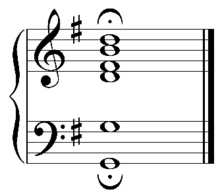Major seventh chord
| Component intervals from root | |
|---|---|
| major seventh | |
| perfect fifth | |
| major third | |
| root | |
| Tuning | |
| 8:10:12:15[1] | |
| Forte no. / | |
|
4-18 / |


In music, a major seventh chord is a seventh chord where the "third" note is a major third above the root, and the "seventh" note is a major seventh above the root (a fifth above the third note) ![]() play . The major seventh chord, sometimes also called a Delta chord, can be written as maj7, M7, Δ, ⑦, 7+, etc. It can be represented by the integer notation {0, 4, 7, 11}. In the case where the seventh note is a minor seventh above the root, it is instead called a dominant seventh chord.
play . The major seventh chord, sometimes also called a Delta chord, can be written as maj7, M7, Δ, ⑦, 7+, etc. It can be represented by the integer notation {0, 4, 7, 11}. In the case where the seventh note is a minor seventh above the root, it is instead called a dominant seventh chord.
In 1888, the French composer Erik Satie composed three slow waltzes, entitled Gymnopédies. The first and best-known of these, (Gymnopedie 1) alternates two major seventh chords :

Later examples of tonic major seventh chords include The Beatles' "This Boy", Bread's "Make It With You", America's "Tin Man", Blood Sweat & Tears' "You've Made Me So Very Happy", third and main part of Paul McCartney and Wings' "Band On The Run", Carly Simon's "The Right Thing To Do" Rupert Holmes' "Him" and, most famously, Chicago's "Colour My World".[4]
Moving in the seventies to replace the prominence of the dominant seventh as a stable tonic more common in the first fifteen years of the rock era, the major seventh was common in all styles, "pervading soul, country rock, soft rock, MOR (middle-of-the-road styles), jazz rock, funk, and disco."[4] "In soul and disco, a tonic minor seventh harmony often alternated with a dominant seventh or dominant ninth chord on ['Lady Marmalade' & 'Le Freak']...In other styles, major seventh and minor seventh chords generally mix (usually with eleventh chords...) to create a diatonic composite in either major or minor mode....The most famous major seventh chord in the history of music, [is] the one that opens...'Colour My World', even though the song departs from the usual pattern described above by 'colouring' the harmonic succession with several chromatic chords. Still, seven of that song's fourteen chords, including the tonic, are major sevenths or ninths, demonstrating the primacy of that chord type."[4]

According to Forte, the major seventh chord is exemplified by IV7, which originates melodically.[5]
The just major seventh chord is tuned in the ratios 8:10:12:15, as a just major chord is tuned 4:5:6 and a just major seventh is tuned 15:8. ![]() Play
Play

Pieces which feature prominent major seventh chords include: "This Guy's in Love with You" by Burt Bacharach and Hal David, Chick Corea's "Litha", Joe Henderson's "Inner Urge", John Lennon's "Imagine", Freddie Hubbard's "Little Sunflower", Tower of Power's So Very Hard to Go, Carole King's "It's too Late", Michel Legrand's "Watch What Happens", Antonio Jobim's "Dindi", Red Hot Chili Peppers' Under The Bridge, Tadd Dameron's "Lady Bird",[6] and Smashing Pumpkin's 1979.
Major seventh chord table
| Chord | Root | Major Third | Perfect Fifth | Major Seventh |
|---|---|---|---|---|
| Cmaj7 | C | E | G | B |
| C♯maj7 | C♯ | E♯ (F) | G♯ | B♯ (C) |
| D♭maj7 | D♭ | F | A♭ | C |
| Dmaj7 | D | F♯ | A | C♯ |
| D♯maj7 | D♯ | F |
A♯ | C |
| E♭maj7 | E♭ | G | B♭ | D |
| Emaj7 | E | G♯ | B | D♯ |
| Fmaj7 | F | A | C | E |
| F♯maj7 | F♯ | A♯ | C♯ | E♯ (F) |
| G♭maj7 | G♭ | B♭ | D♭ | F |
| Gmaj7 | G | B | D | F♯ |
| G♯maj7 | G♯ | B♯ (C) | D♯ | F |
| A♭maj7 | A♭ | C | E♭ | G |
| Amaj7 | A | C♯ | E | G♯ |
| A♯maj7 | A♯ | C |
E♯ (F) | G |
| B♭maj7 | B♭ | D | F | A |
| Bmaj7 | B | D♯ | F♯ | A♯ |
Sources
- ↑ Shirlaw, Matthew (1900). The Theory of Harmony, p.86. ISBN 978-1-4510-1534-8.
- 1 2 Benward & Saker (2003). Music: In Theory and Practice, Vol. I, p.229. Seventh Edition. ISBN 978-0-07-294262-0.
- ↑ Walter Everett (Autumn, 2004). "A Royal Scam: The Abstruse and Ironic Bop-Rock Harmony of Steely Dan", p.205, Music Theory Spectrum, Vol. 26, No. 2, pp. 201-235.
- 1 2 3 Stephenson, Ken (2002). What to Listen for in Rock: A Stylistic Analysis, p.83. ISBN 978-0-300-09239-4. "...the most famous major seventh chord in the history of music, the one that opens Chicago's 'Colour My World'..."
- 1 2 Forte, Allen (1979). Tonal Harmony in Concept & Practice, p.150. ISBN 0-03-020756-8.
- ↑ Radley, Roberta (2011). The "Real Easy" Ear Training Book, pages unmarked. ISBN 9781457101427